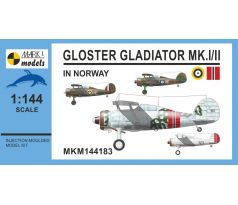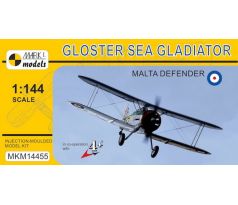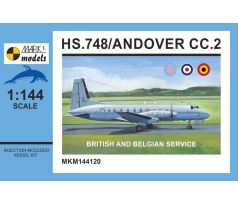Mark I Models 1:144 - Page 4

Gloster Gladiators ‘In Norway’
Colour schemes included in the kit:
A: Gloster Gladiator Mk.II, N5905, Grey HE-N, No.263 Sq., RAF, Norwegian Campaign, Bardufoss airfield, Norway, May/June 1940
B: Gloster Gladiator Mk.II, N5725, Grey HE-J, No.263 Sq., RAF, Norwegian Campaign, Lake Lesjaskog (frozen lake serving as a temporary airfield), Norway, April-May 1940
C: Gloster Gladiator Mk.I, Black 423, Norwegian Army Air Service (Hærens flyvåpen), Kjeller airfield, Norway, 1938-39
D: Gloster Gladiator Mk.II, Black 433, Fighter Wing (Jagevingen), Norwegian Army Air Service (Hærens flyvåpen), Fornebu Airport, Norway, April-May 1940

Gloster Sea Gladiator 'Malta Defender'
Description: This injection-moulded kit contains 39 parts and one clear part (cockpit canopy). A comprehensive instruction leaflet and a decal sheet are included.
Colour schemes included in the kit:
1) Gloster Sea Gladiator, N5520, Black S, 'Faith' of the Hal Far Fighter Flight, RAF, Hal Far airfield, Malta, June 1940
2) Gloster Sea Gladiator, N5531, 'Hope' of the Hal Far Fighter Flight, RAF, Hal Far airfield, Malta, June 1940
3) Gloster Sea Gladiator, N5519, Black R, 'Charity' of the Hal Far Fighter Flight, RAF, Hal Far airfield, Malta, June 1940
4) Gloster Sea Gladiator, N5525, No.802 NAS, Royal Navy, HMS Glorious, based at Aboukir airfield, Egypt, summer 1939

Harrier GR.1/VA.1 Matador
Description: One injection-moulded kit is supplied in this box; it contains 54 parts and one clear part (the cockpit canopy). A comprehensive decal sheet is included.
Colour schemes included in the kit:
1) Hawker Siddeley Harrier GR Mk.1, XV782, Black D, No.4 Sq., RAF, Wildenrath Air Base, Germany, 1972-73
2) Hawker Siddeley Harrier GR Mk.1A, XV755, Red 20, No.1(F) Sq., RAF, Wittering Air Base, Cambridgeshire, U.K., during Exercise 'Sky Mist', Scotland, winter 1972/73
3) VA.1 Matador (Hawker Siddeley Harrier Mk.53/AV-8S), VA.1-3, 01-804, Black 4, 008 Esc. (Sq.), Spanish Navy (Arma Aerea de la Armada Espanola), Naval Station Rota, Spain, early 1990s
4) AV-8A Harrier (British Aerospace Harrier Mk.55), ex-VA.1 Matador, 161176 (ex-VA.1-8), Black 3108/8, No. 301 Sq., Royal Thai Navy (Kong Thap Ruea Thai), alternating between Royal Thai Naval Base U-Tapao and HTMS Chakri Naruebet (CVH-911), 1997

Harrier GR.1A/AV-8A/C 'First Generation'
Description: One injection-moulded kit is supplied in this box; it contains 54 parts and one clear part (the cockpit canopy). A comprehensive decal sheet is included.
Colour schemes included in the kit:
1) Hawker Siddeley Harrier GR Mk.1, XV741, White XV741, Aeroplane and Armament Experimental Establishment (A&AEE), MoD/RAF, Boscombe Down Air Base, Wiltshire, U.K., flown by Flt.Lt. T. Lecky-Thompson during the Daily Mail Transatlantic Air Race, May 1969
2) Hawker Siddeley Harrier GR Mk.1, XV759, No.233 OCU (Operational Conversion Unit), RAF, Wittering Air Base, Cambridgeshire, U.K., 1971
3) AV-8A Harrier (Hawker Siddeley Harrier Mk.50), BuNo 158707/WH12, White 12/Black WH, VMA-542 (Marine Attack Squadron 542) 'Tigers', US Marine Corps, MCAS Cherry Point, North Carolina (detachment MCAS Yuma, Arizona), U.S.A., 1974
4) AV-8C Harrier (Hawker Siddeley Harrier Mk.50), BuNo 159374/KD14, White 14/KD, VMAT-203 (Marine Attack Training Squadron 203) 'Hawks', US Marine Corps, MCAS Cherry Point, North Carolina, U.S.A., mid-1980s

Harrier GR.3 'Laser Nose'
Description: One injection-moulded kit is supplied in this box; it contains 53 parts and one clear part (the cockpit canopy). A comprehensive decal sheet is included.
Colour schemes included in the kit:
1) Hawker Siddeley Harrier GR Mk.3, XZ130, Red 27, No.1(F) Sq., RAF, Wittering Air Base, Cambridgeshire, U.K., during Exercise 'Cold Winter', Bardufoss Air Station, Norway, March 1979
2) Hawker Siddeley Harrier GR Mk.3, ZD667, No.4 Sq., RAF, Gutersloh Air Base, Germany, late 1980s
3) Hawker Siddeley Harrier GR Mk.3, XZ990, Black F, 'Foxy', No.1417 Flt., RAF, Belize Airport, Belize, Central America, 1990
4) Hawker Siddeley Harrier GR Mk.3, XV809, Yellow AF, No.3(F) Sq., RAF, during Exercise 'Match Coat', Gutersloh Air Base, Germany, September 1984

Harrier GR.3 'Operation Corporate'
Description: One injection-moulded kit is supplied in this box; it contains 53 parts and one clear part (the cockpit canopy). A comprehensive decal sheet is included.
Colour schemes included in the kit:
1) Hawker Siddeley Harrier GR Mk.3, XV789, Red 32, No.1(F) Sq., RAF, HMS Hermes, FOB (Forward Operating Base) Port San Carlos and Port Stanley Airport, during 'Operation Corporate', the Falkland Islands, May-June 1982
2) Hawker Siddeley Harrier GR Mk.3, XZ963, Red 14, No.1(F) Sq., RAF, HMS Hermes, FOB (Forward Operating Base) Port San Carlos and Port Stanley Airport, during 'Operation Corporate', the Falkland Islands, May-June 1982
3) Hawker Siddeley Harrier GR Mk.3, XZ972, Red 33, No.1(F) Sq., RAF, HMS Hermes, FOB (Forward Operating Base) Port San Carlos and Port Stanley Airport, during 'Operation Corporate', the Falkland Islands, May-June 1982
4) Hawker Siddeley Harrier GR Mk.3, XZ989, Red 07, No.1(F) Sq., RAF, HMS Hermes, FOB (Forward Operating Base) Port San Carlos and Port Stanley Airport, during 'Operation Corporate', the Falkland Islands, May-June 1982

Harrier GR.3/AV-8A/AV-8C ‘Special Markings’ MKM144119
One injection-moulded kit is supplied in this box; it contains 48 parts and one clear part (the cockpit canopy). A comprehensive decal sheet is included.
Colour schemes included in the kit:
1) Hawker Siddeley Harrier GR Mk.3, XV738, Grey B, No.4 Sq., RAF, during 'Exercise Match Coat', Gutersloh Air Base, Germany, September 1984
2) Hawker Siddeley Harrier GR Mk.3, XZ129/A2604 (ex-RAF a/c), Black ETS, Engineering Training School (ETS), RN, serving as an instructional airframe, RNAS Yeovilton (HMS Heron), Somerset, U.K., 1992-94
3) AV-8A Harrier (Hawker Siddeley Harrier Mk.50), BuNo 158703, White 703, VMA-513 (Marine Attack Squadron 513) 'Flying Nightmares', US Marine Corps, Sheppard AFB, Texas, U.S.A., April 1980
4) AV-8C Harrier (Hawker Siddeley Harrier Mk.50), BuNo 158387/N719NA, Black 719, National Aeronautics and Space Administration (NASA), Ames Research Center, NAS Moffett Field, California, U.S.A., 1986-1995

Hawker-Siddeley HS.748 'The Budgie'
This injection-moulded kit contains 51 parts. For modeller's convenience a display base, made of pasteboard card, depicting tarmac section of the military airport is added. A comprehensive instruction leaflet and a decal sheet are included.
Colour schemes included in the kit:
1) Avro 748 (Srs.1 Model 200) G-ARAY (c/n 1535), (Srs.1 Model 101) G-ARMW (c/n 1537), (Srs.1 Model 101) G-ARMX (c/n 1538), (Srs.1 Model 106) G-ARRW (c/n 1549) or Hawker Siddeley HS.748 (Srs.2 Model 108) G-ASPL (c/n 1560), (Srs.2 Model 232) G-AZSU (c/n 1612), Dan Air Services Ltd. (Dan-Air Skyways), flown between various regional and European airports, U.K., 1972-73
2) Hawker Siddeley HS.748 (Srs.2A Model 334), G-GLAS (c/n 1756) or G-EDIN (c/n 1757), Chieftain Airways PLC, flown between Scotland and European airports, Scotland, U.K., 1987
3) Hawker Siddeley HS.748 (Srs.2 Model 215), YV-05C (c/n 1578), Linea Aeropostal Venezolana S.A. (LAV), Caracas - Simon Bolivar International Airport (Aeropuerto Internacional de Maiquetia "Simon Bolivar"), Venezuela, 1980-82

Hawker-Siddeley HS.748 Andover Military 'Asia & Australia' (RAF ME, RAAF, Royal Thai AF)
This injection-moulded kit contains 51 parts. For modeller's convenience a display base, made of pasteboard card, depicting tarmac section of the military airport is added. A comprehensive instruction leaflet and a decal sheet are included.
The HS.748 was a British short/medium-range twin-engined airliner designed during the late 1950s. It was originally developed and initially produced by A.V. Roe & Co., then" after its dissolution" by Hawker Siddeley Aviation and later by its successor, British Aerospace.
The 748 was a remarkably successful aeroplane and an effective DC-3 replacement in many parts of the world. The first prototype (G-APZV) first flew in June 1960. Initially, the Srs.1 version for 44 passengers was built (24 a/c), then production was switched to the 52-seat Avro 748 Srs.2, followed by the Srs.2A and 2B with further increases in power and maximum weight. A total of 350 HS.748s were built which also included 89 aircraft manufactured by Indian Hindustan Aeronautics and this type continued in production until 1988.
The HS.748 was a low-wing monoplane of an all-metal construction, fitted with a nose-wheel type tricycle undercarriage. The flight crew consisted of two members, while the cabin accommodated passengers or could be adjusted to mixed passenger/freight layout.
Powered by two Dart turboprop engines, it possessed a high level of performance, including short takeoff and landing (STOL) capabilities and overall ruggedness. In freight configuration the aircraft was capable of hauling payloads in excess of 10,000 lb (4,540 kg).
Significant users included the RAF, the Royal Australian Air Force and the Indian and Brazilian Air Forces, while the majority of the 748s were flown by various British and overseas airline operators.

Hawker-Siddeley HS.748 Andover Military 'Europe' (RAF, RAE, Belgian AF)
This injection-moulded kit contains 51 parts. For modeller's convenience a display base, made of pasteboard card, depicting tarmac section of the military airport is added. A comprehensive instruction leaflet and a decal sheet are included.
The HS.748 was a British short/medium-range twin-engined airliner designed during the late 1950s. It was originally developed and initially produced by A.V. Roe & Co., then" after its dissolution" by Hawker Siddeley Aviation and later by its successor, British Aerospace.
The 748 was a remarkably successful aeroplane and an effective DC-3 replacement in many parts of the world. The first prototype (G-APZV) first flew in June 1960. Initially, the Srs.1 version for 44 passengers was built (24 a/c), then production was switched to the 52-seat Avro 748 Srs.2, followed by the Srs.2A and 2B with further increases in power and maximum weight. A total of 350 HS.748s were built which also included 89 aircraft manufactured by Indian Hindustan Aeronautics and this type continued in production until 1988.
The HS.748 was a low-wing monoplane of an all-metal construction, fitted with a nose-wheel type tricycle undercarriage. The flight crew consisted of two members, while the cabin accommodated passengers or could be adjusted to mixed passenger/freight layout.
Powered by two Dart turboprop engines, it possessed a high level of performance, including short takeoff and landing (STOL) capabilities and overall ruggedness. In freight configuration the aircraft was capable of hauling payloads in excess of 10,000 lb (4,540 kg).
Significant military users included the RAF, the Royal Australian and the Royal Thai Air Forces. Lower numbers of the 748 were delivered to air forces of Belgium, Brazilia, Colombia, Ecuador and India, while the majority of the 748s were flown by various British and overseas airline operators.

Hawker-Siddeley HS.748/BAe.748 'In Civilian Skies'
This injection-moulded kit contains 51 parts. For modeller's convenience a display base, made of pasteboard card, depicting tarmac section of the civil airport is added. A comprehensive instruction leaflet and a decal sheet are included.
Hawker-Siddeley HS.748/BAe.748 'In Civilian Skies' re-release, new decals,
Hawker Siddeley HS.748/British Aerospace BAe.748 'In Civilian Skies'
(British Airways, Emerald Airways, West Air Sweden)
Colour schemes included in the kit:
1) Hawker Siddeley HS.748 (Srs.2A Model 245), G-BFLL (c/n 1658), 'Glen Esk/Gleann Uisge', British Airways Ltd., Glasgow Airport, Renfrewshire, Scotland, U.K., 1983-84
2) British Aerospace BAe.748 (Srs.2A Model 372), G-BVOV (c/n 1777), Emerald Airways Ltd., Liverpool/John Lennon Airport, Merseyside, England, U.K., 1994-2006
3) Hawker Siddeley HS.748 (Srs.2A Model 229), SE-LIF (c/n 1596), 'Number 10', West Air Sweden, Lidkoping-Hovby and Sturup/Malmo Airports, Sweden, 1997-2007

Heinkel He-219A-0/LB-79 'Flying Laboratory'
Description: This injection-moulded kit contains 35 parts, one clear part (the cockpit canopy) and a small fret with 41 photo-etched parts. For modeller's convenience a display base, made of pasteboard card, depicting a section of the Luftwaffe military airfield is added. A comprehensive instruction leaflet and a decal sheet are included.
Colour schemes included in the kit:
1) He-219A-0, DV+DL (W.Nr. 190116), Luftwaffe, Werneuchen airfield, Germany, summer 1944
2) He-219A-0, DV+DI, Black 113 (W.Nr. 190113), Luftwaffe, Rechlin-Lärz Air Base, Germany, 1943-44
3) He-219A-0/R6, G9+FK (W.Nr. 190012), 2./NJG 1, Luftwaffe, Venlo-Herongen airfield, the Netherlands, April 1944
4) LB-79 (He-219A-5), Black 32, LVÚ Aviation Research Institute, serving with 2nd Sq., 51st Air Regiment, Czechoslovak Air Force, Plzeň-Bory airfield, Czechoslovakia, early 1952

Heinkel He-219A-2 'Night Hunter'
Heinkel He-219A-2 'Night Hunter' includes a small fret with photo-etched parts (aerials, cockpit seats and other details

Heinkel He-219A-5 'Night Owl'
Heinkel He-219A-5 'Night Owl' includes a small fret with photo-etched parts (aerials, cockpit seats and other details



